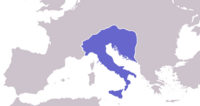Fall of Rome
The Fall of the Western Roman Empire (395–476)
The year 476 is generally accepted as the end of the Western Roman Empire. Before this, in June 474, Julius Nepos became Western Emperor. The Master of Soldiers Orestes revolted and put his son Romulus Augustus on the throne and Nepos fled back to his princedom in Dalmatia in August 475. Romulus however, was not recognized by the Eastern Emperor Zeno and so was technically a usurper, Nepos still being the legal Western Emperor.
The Germanic Heruli, under their chieftain Odoacer, were refused land by Orestes, whom they killed. They then deposed Romulus Augustus in August 476. Odoacer then sent the Imperial Regalia back to the emperor Zeno, and the Roman Senate informed Zeno that he was now the Emperor of the whole empire. Zeno soon recieved two deputations. One was from Odoacer requesting that his control of Italy be formally recognized by the Empire, in which he would acknowledge Zeno's supremacy. The other deputation was from Nepos, asking for support to regain the throne. Zeno granted Odoacer the title Patrician.
Odoacer and the Roman Senate were told to take Nepos back. However, Nepos never returned from Dalmatia, even though Odoacer issued coins in his name. Upon Nepos' death in 480, Odoacer annexed Dalmatia to his kingdom.
The next seven decades played out as aftermath. Theodoric the Great as King of the Oastrogoths, couched his legitimacy in diplomatic terms as being the representative of the Emperor of the East. Consuls were appointed regularly through his reign: a formula for the consular appointment is provided in Cassiodorus's Book VI. The post of consul was last filled in the west by Theodoric's successor, Athalaric, until he died in 534. Ironically the Gothic War in Italy, which was meant as the reconquest of a lost province for the Emperor of the East and a re-establishment of the continuity of power, actually caused more damage and cut more ties of continuity with the Antique world than the attempts of Theodoric and his minister Cassiodorus to meld Roman and Gothic culture within a Roman form.
In essence, the "fall" of the Roman Empire to a contemporary depended a great deal on where they were and their status in the world. On the great villas of the Italian Campagna, the seasons rolled on without a hitch. The local overseer may have been representing an Ostrogoth, then a Lombard duke, then a Christian bishop, but the rhythm of life and the horizons of the imagined world remained the same. Even in the decayed cities of Italy consuls were still elected. In Auvergne, at Clermont, the Gallo-Roman poet and diplomat Sidonius Apollinaris, bishop of Clermont, realized that the local "fall of Rome" came in 475, with the fall of the city to the Visigoth Euric. In the north of Gaul, a Roman kingdom existed for some years and the Franks had their links to the Roman administration and military as well. In Hispania the last Arian Visigothic king Liuvigild considered himself the heir of Rome. Hispania Baetica was still essentially Roman when the Moors came in 711, but in the northwest, the invasion of the Suevi broke the last frail links with Roman culture in 409. In Aquitania and Provence, cities like Arles were not abandoned, but Roman culture in Britain collapsed in waves of violence after the last legions evacuated: the final legionary probably left Britain in 409.
Template:Credit:70344512
